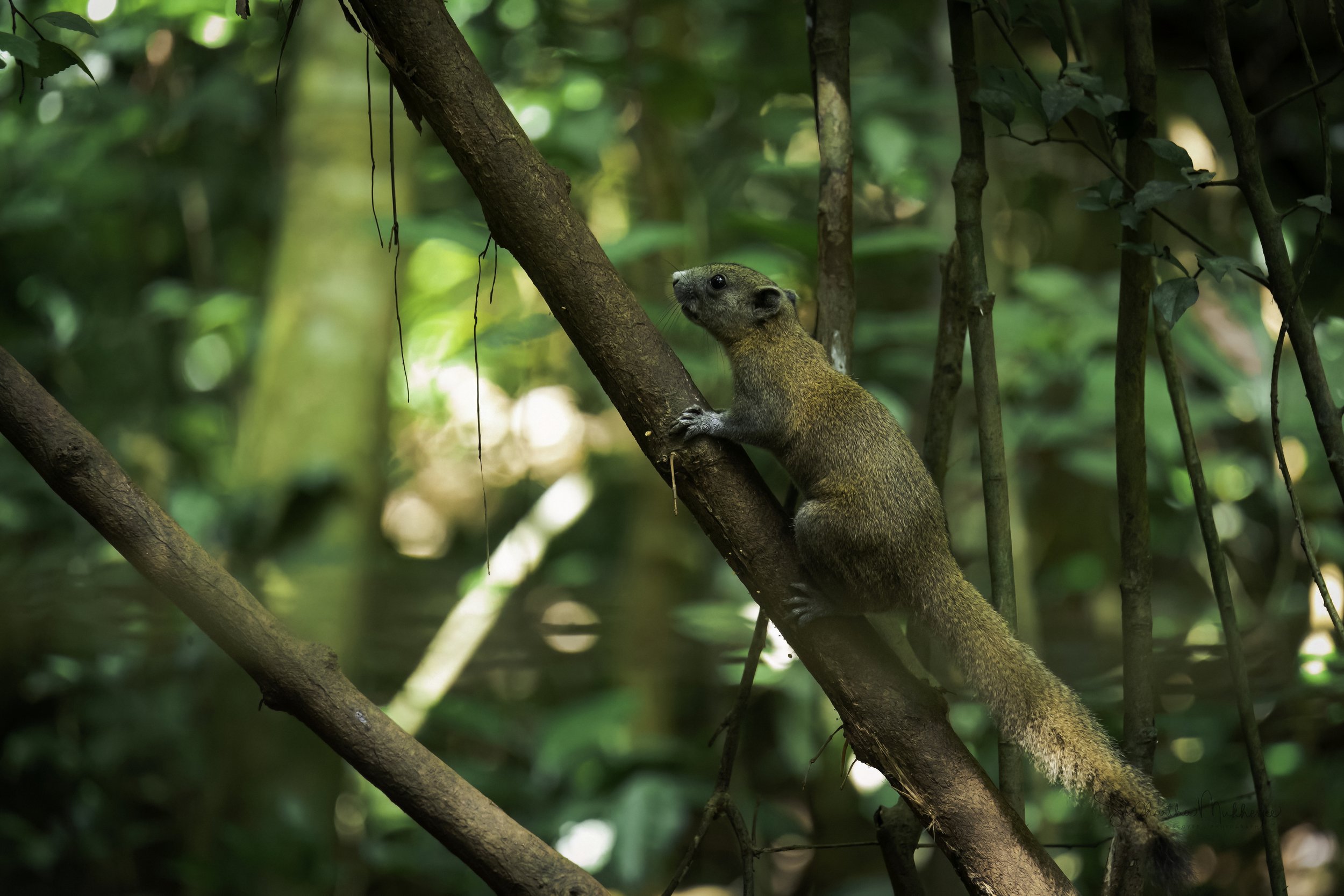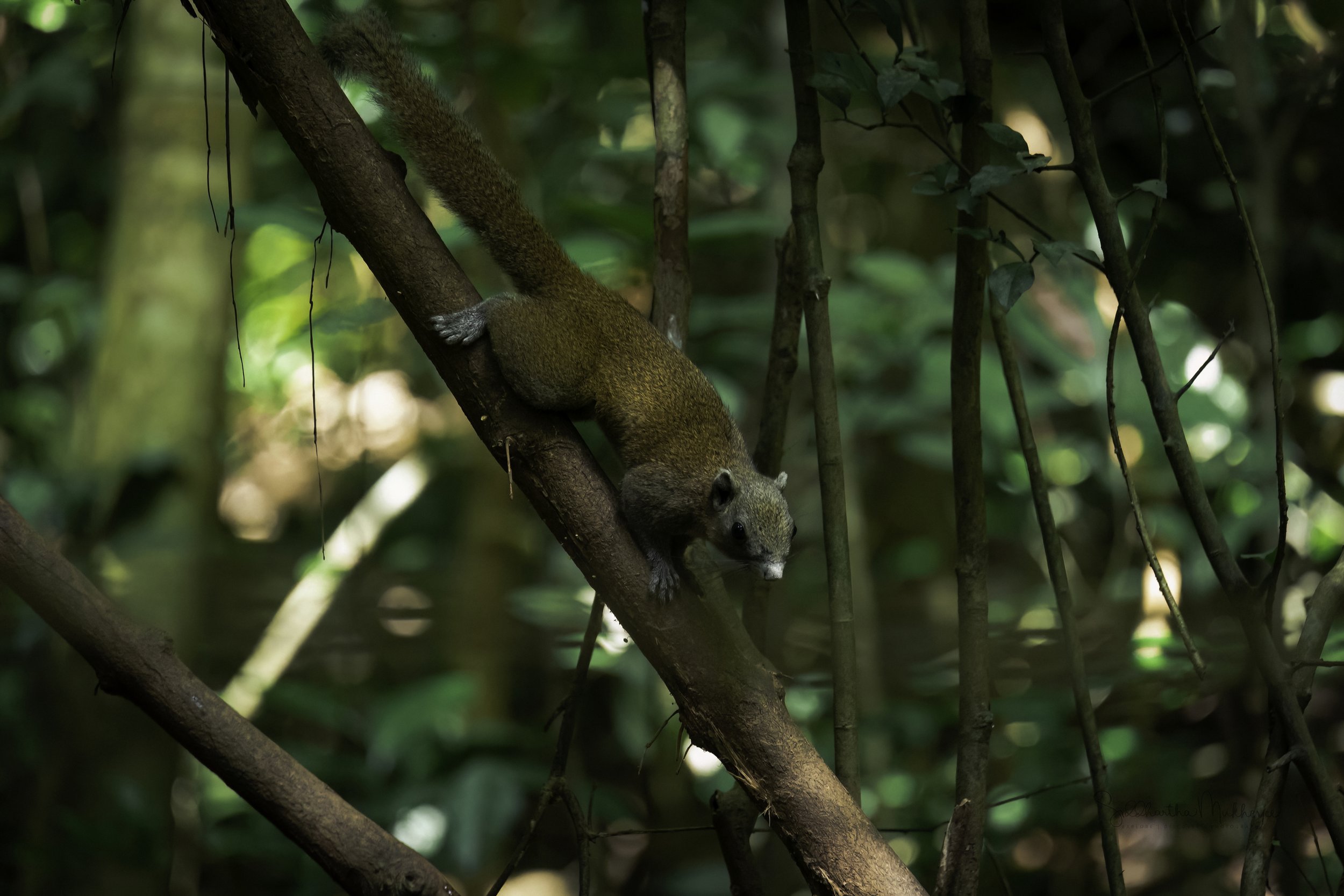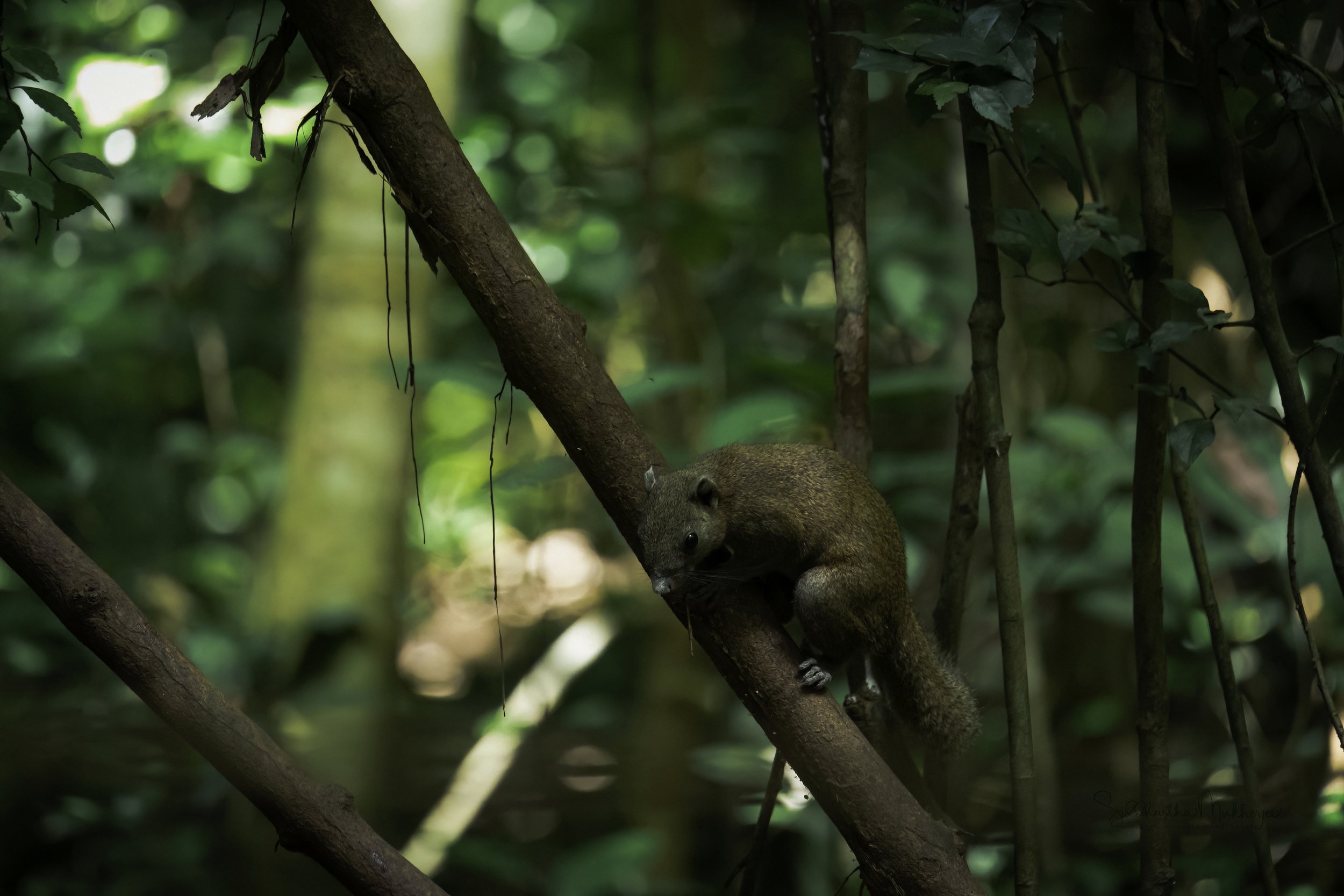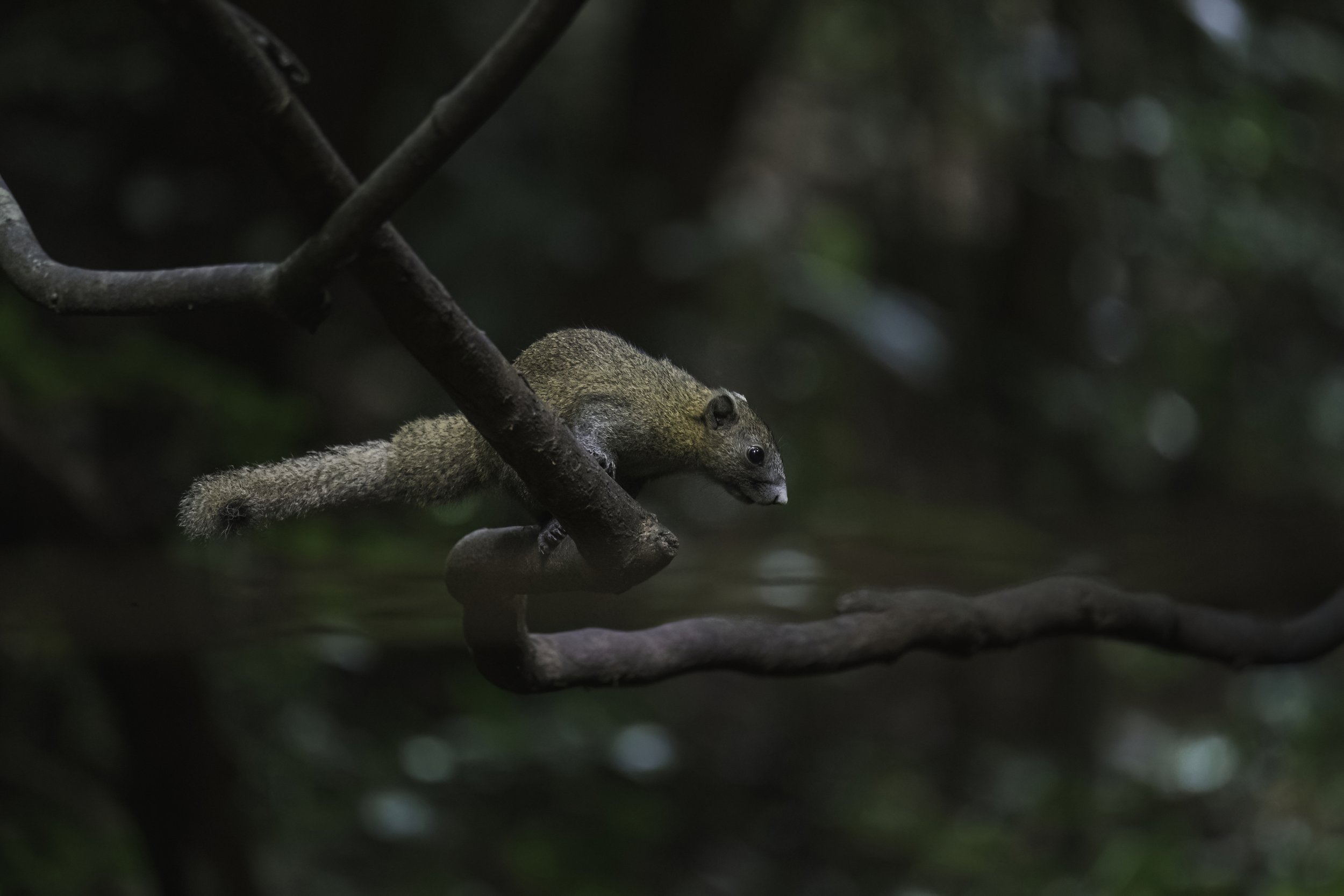Horse-tailed Squirrel
Sundasciurus hippurus
NEAR THREATENED
Kaeng Krachan National Park, Thailand
Today is another brief but very satisfying encounter in the wild with the Near Threatened most colorful and largest of the Sundasciurus tree squirrels- The Horse-tailed Squirrel. This is a medium-sized squirrel with a head-to-body length of 21.5 to 25 cm (8.5 to 9.8 in) and a tail length of 24 to 29 cm (9.4 to 11.4 in). It has a grizzled grey head, shoulders, forefeet and body with a whitish, dull orange, or red-brown underbelly. The tail of this squirrel is commonly a glossy black or grey banded with black.
Kaeng Krachan NP is the largest national park of Thailand on the border with Burma, contiguous with the Tanintharyi Nature Reserve. It is located in Phetchaburi and Prachuap Khiri Khan Provinces, about 60 km from Phetchaburi and 75 km from Hua Hin. Covering an area of 2,914 km² it is the largest national park in Thailand. The park is part of the Western Forex Complex that covers 18,730 km² across 19 protected sites between Myanmar and Thailand, bounded by the Tanintharyi Nature Reserve along Myanmar's border to the west. A dense rain forest on the eastern slope of the Tenasserim Mountain Range where the Pranburi & Phetchaburi Rivers originate. Both rivers originate from the Tanaosri Mountain Range. In the north, Phetchaburi River flows into Kaeng Krachan Dam and flows further east all the way out to the Gulf of Thailand. Pran Buri River flows south to Prachuap Khiri Khan Province, into Pran Buri Reservoir and out to the Gulf of Thailand.
The park was declared a reserve in 1964 and on 12 June 1981 it became the 28th national park of Thailand. Originally covering an area of 2,478 km2, it was enlarged in December 1984 to include the boundary area between Phetchaburi and Prachuap Khiri Khan Provinces, an additional 300,000 rai. The park has been included in the list of ASEAN Heritage Parks. Since 2011, Thailand has proposed that Unesco designate Kaeng Krachan National Park a world heritage site.
Mammal species such as leopards, clouded leopards, bears, stump-tailed macaques, sambar deer, barking deer, elephants, dholes, golden jackals, gaurs, serows, yellow-throated martens, various civet species, crab-eating mongooses and many others can be found in the park.
Horse-tailed Squirrel
The Horse-tailed Squirrel (Sundasciurus hippurus) is a species of rodent in the family Sciuridae found throughout the islands of Borneo and Sumatra, as well as the southern half of the Malay Peninsula, which includes the entire nations of Brunei and Malaysia, as well as some areas of Indonesia and Thailand. There was a mention of this squirrel being found in Vietnam in 1831 (I. Geoffroy, 1831), but subsequent descriptions of this squirrel's range have not included that nation.
Sundasciurus hippurus is the largest & most colourful of the Sunda tree squirrels, Sundasciurus, with considerable geographical colour variation in Borneo. It is a medium-sized squirrel with a head-to-body length of 21.5 to 25 cm (8.5 to 9.8 in) and a tail length of 24 to 29 cm (9.4 to 11.4 in). The horse-tailed squirrel has a grizzled grey head, shoulders, forefeet and body with a whitish, dull orange, or red-brown underbelly. The tail of this squirrel is commonly a glossy black or grey banded with black. This grey pelage may be more or less grizzled. The upperparts are reddish brown to chestnut. Subspecies differ, the hind legs may be grey or reddish brown and the underside is whitish, dull orange, or reddish brown. The tail is glossy black or grey and black banded. Despite the common name, horse-tailed squirrel, the tail is not very similar to that of a horse. There are some individuals resembling Callosciurus erythraeus. But in northern Malaysia, where both species occur, horse-tailed squirrels have uniform red undersides, not agouti, and darker and more bushy tails. (Payne, 1985, Lekagul & McNeely, 1977 ; Medway, 1978 ; Corbet & Hill, 1992)
It inhabits primary rainforest and mature secondary forest up to about 1500 metres elevation. It is mainly arboreal, but occasionally ventures to the lower parts of trees, or even to the ground to forage. In the field it is identified by its thick, dark, bushy tail which contrasts with the body fur (some specimens in Borneo may have a reddish-brown tip to the tail). There are many subspecies, with varying fur colour. The body fur can vary from grey to light brown on the upperside, and from reddish brown to white on the underside. The head is dark grey. Its diet comprises mainly forest fruits and seeds, though small insects may also be eaten. Sundasciurus hippurus ranges from southern Thailand through Peninsular Malaysia to Borneo and Sumatra. It is not recorded from Singapore. Lifespan is unknown in these squirrels but most squirrel species have lifespans averaging 3 to 7 years.
Very little is known about the mating behaviour and systems in the Sundasciurus species. These squirrels probably breed throughout the year. Females have two or three pairs of mammae. Little is known of reproduction in these squirrels but perhaps, as in other diurnal squirrels in that region, they produce young throughout the year. Two close relatives, Low's Squirrel (Sundasciurus lowii) and Slender Squirrel (Sundasciurus tenuis), have litter sizes of 2-4 & little is known of parental investment in these squirrels. Females care for and nurse their offspring until independence in a tree nest.
Horse-tailed squirrels are diurnal. They are solitary or occur in pairs (Medway, 1978) They feed and move mainly in the lower and middle part of the understory, but nest in the upper canopy. Sometimes they came to the ground. In Malaysia they share their habitat with Plantain Squirrel (Callosciurus notatus) and Black-striped squirrel (Callosciurus nigrovittatus) in the same understory (8-18 m). Larger diurnal squirrels tend to live in the upper canopy and smaller species from the ground level through the lower canopy. (McKinnon, in McDonald, 2001).
The most commonly heard call is "CHEK!.....CHEK!.......chekchekchekchek....." (Payne, 1985)
Horse-tailed squirrels probably also communicate through visual, chemical, and tactile cues. Diurnal tree squirrels typically have exceptional vision and vibrissae on the chin and limbs that aids in the perception of surfaces, making these animals quite agile climbers. (Payne, J, et al., 1985).
Horse-tailed squirrels feed on seeds, fruits, and arthropods. In Malaysia they are reported to feed on bark and sap, while sympatric beautiful squirrels (Callosciurus species) feed more opportunistically on different plant material and insects (McKinnon in McDonald, 2001). Like other squirrels, they may include a diversity of foods in their diet, such as eggs, young vertebrates, and fungi. (McDonald David, 2001; Nowak, 1997)
Horse-tailed squirrels avoid predation primarily through their agility and vigilance in the trees. Few predators can chase and capture adults in the forest canopy. Young squirrels are vulnerable to predation in the nest by small, arboreal predators such as snakes, cats, or other squirrels. Their coloration may make them cryptic in the forest canopy.
These Horse-tailed squirrels are important seed dispersers in primary and secondary lowland forests throughout their range and may help to disperse the seeds of important lowland tree species.. They may also serve as an important prey base for large predators, such as raptors.
There are no negative impacts of horse-tailed squirrels on humans.
Horse-tailed squirrels are threatened by habitat destruction throughout their range and have most recently been assessed for The IUCN Red List of Threatened Species in 2016. Sundasciurus hippurus is listed as Near Threatened under criteria A2c.
‡‡‡‡‡
Related Posts


















